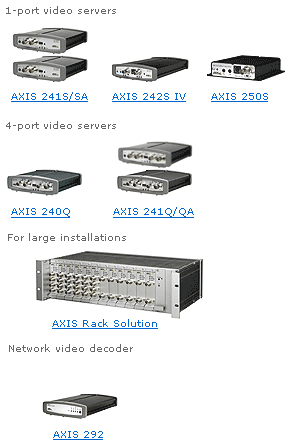|
Our video servers integrate easily
into your existing analog CCTV (closed circuit television)
system. You can acquire all the benefits that digital
technology offers without scrapping your investment in an
analog system.
What is a video server?
A video
server digitizes analog video signals and sends digital
images directly over an IP
network, such as a LAN, intranet or Internet. It
essentially turns an analog video system into a network
video system and enables users to view live images using a
Web browser or an video
management software on any local or remote computer on a
network. It allows authorized viewers from different
locations to simultaneously access images from the same
analog camera, as well as network cameras if they are added
to the system.
Remote accessibility
An IP-based
surveillance system will give you the ability to secure
people and property, or monitor equipment and facilities,
remotely from anywhere there is a networked computer. In
addition, by utilizing the serial ports of a video server,
you can remotely control existing equipment such as
pan/tilt/zoom devices or time-lapse tape recorders. A video
server can be connected to a wide variety of specialized
cameras such as a miniature or microscope camera. More
benefits of going digital.
Alarm management
You gain a wide range of features
such as e-mail notification upon alarm, and integration
possibilities with other security devices through
a video server's digital inputs and
outputs (I/O). Digital inputs can be used to
trigger the transmission of images from the video
server upon alarm. Digital outputs can be used to
remotely or automatically open or close doors, turn
lights on or off, and control temperature levels.
Extend the possibilities of your analog CCTV
system
By combining an
analog CCTV system with a network video system,
you can easily and cost-effectively expand the
surveillance system, and reduce total installation and
maintenance costs.
Going digital means you'll
have crisp, quality images. Images from an alarm event
could be easily and quickly distributed via computer
networks |
 |
to many people in different locations for
further examination. A video server's image buffers
can save and send images collected before an alarm
occurred. Images can be stored on a hard disk at
remote locations for convenience and/or security
purposes. There is no need to buy or change video
tapes, or service the video recorder. Digital
storage also reduces the risk of image degradation
and provides quick and easy search capabilities. |
|



